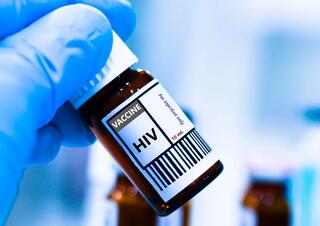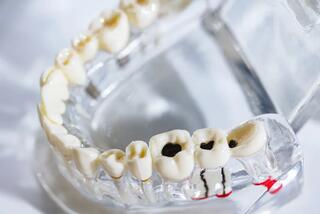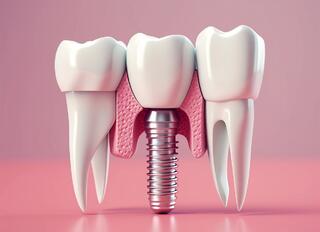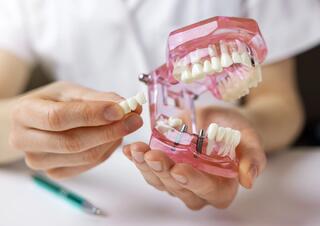Performing dental implantation on HIV patients has long ceased to be forbidden. Modern methods and approaches allow this procedure to be performed safely, but under certain conditions. In this article, we will consider which factors should be taken into account, how to prepare for implantation, what risks exist, and what recommendations doctors provide. Learn about some important details before making a decision to ensure a successful outcome.
In the past, HIV was seen as a death sentence and was an absolute contraindication for installing dental implants. Fortunately, a lot has changed. Modern antiretroviral therapy has allowed people with HIV to lead a normal life, maintain their health, and restore their teeth with implants.
In this article, we will discuss the recommendations to follow for successful implantation in HIV-positive patients, which method is best to reduce the risk of complications, and what results of dental implantation in HIV researchers obtained from several scientific studies conducted in the USA and Europe.
How HIV Affects Oral Health
The human immunodeficiency virus (HIV) negatively impacts all body systems, but some of the earliest symptoms appear in the oral cavity. Why does this happen?
The main reason is immune suppression, which creates favorable conditions for bacterial overgrowth and weakens the body's natural defense mechanisms against infections and tumor formation. As a result, oral health issues often become early indicators of HIV progression. HIV virus cells lead to pathologies in the oral cavity, among other things Common Oral Pathologies in HIV Patients:

Common Oral Pathologies in HIV Patients:
-
Candidiasis
Diagnosed in 75% of HIV patients, candidiasis is accompanied by dryness, itching, and burning in the mouth. Depending on the form, it may present with a white or yellow coating covering the reddened mucosa. -
Oral Hairy Leukoplakia
This condition signals a significant increase in HIV RNA levels. It appears as hair-like growths, typically on the sides of the tongue, ranging from a few millimeters to 3 centimeters in length. The disease progresses without inflammation or pain. -
Periodontal Diseases
Gingivitis quickly develops into periodontitis, where not only the gum’s surface layers become inflamed, but also the supporting structures of the teeth. While these conditions are common in healthy individuals, they progress rapidly and respond poorly to treatment in HIV patients. -
Kaposi's Sarcoma
A malignant tumor more commonly found in men. It appears not only on the skin but also in the mouth, often on the palate or gums. It manifests as bright red, purplish, or violet spots. In later stages, the lesions darken, grow larger, may protrude above the mucosa, form lobules, or ulcerate.
Reducing Risks and Improving Oral Health
To lower the risk of these diseases and ensure better conditions for dental implants and prosthetics, antiretroviral therapy (ART) is prescribed. By week 4–8, the viral load decreases tenfold, and by week 24, HIV RNA becomes undetectable in lab tests.
At the same time, CD4 lymphocyte levels increase. These immune cells protect the body by identifying bacteria, viruses, and fungi. As CD4 levels rise, secondary infections and oral pathologies tend to regress.
Can Dental Implants Be Placed in HIV Patients?
Dental implantation is possible for individuals diagnosed with HIV, but several key factors influence the success of the procedure. International and national dental associations provide the following recommendations:
Key Conditions for Implantation
- CD4 count must be above 200 cells/mm³ and viral load must be undetectable.
-
In a healthy person, CD4 lymphocyte levels range from
450 to 1600 cells/mm³.
- With CD4 above 500, the risk of complications is the same as in healthy individuals.
- With CD4 between 400–450, the risk of implant failure increases, but the procedure is still possible.
- With CD4 below 350, implantation is not performed until the CD4 count improves through treatment.
- Viral load (HIV RNA in blood plasma) must be below 50 copies/mL, meaning it should be undetectable in lab tests.
Pre- and Post-Operative Monitoring
- Regular CD4 and viral load tests are required before surgery.
- Stable immune function must be maintained after implantation for proper gum healing and bone integration.
-
Patients should see an
infectious disease specialist regularly:
- Every 6 months if CD4 is above 500.
- Every 3 months if CD4 is below 500 or for advanced HIV stages.
Additional Precautions
Antibiotic Prophylaxis
- Prevents infections and implant rejection.
- Even with sterile surgical conditions, oral bacteria can still cause complications.
- Mouth rinses and antiseptic treatments help, but antibiotics provide additional protection.
Minimally Invasive Implantation
- Instead of cutting and peeling back gum tissue, the implant is inserted through a small puncture.
- Computer-guided surgery ensures precise placement, minimizing trauma to gums and bone.
- A surgical guide is used to position the implants accurately, reducing risks and improving healing.
- University of Texas (Houston): 100% of 40 implants successfully integrated after 6 months.
- University of São Paulo: 39 implants showed 100% success after 12 months.
- University of Valencia: A review of 173 implants in HIV-positive patients found only 1 failure over 30 months
Absolute Contraindications for Dental Implantation
There are certain conditions where dental implantation is strictly prohibited. In such cases, the dentist opts for alternative tooth replacement methods, such as bridges, removable partial dentures, or acrylic prostheses.
Absolute Contraindications:
- Chemotherapy or radiotherapy in the head and neck region (due to cancer treatment).
- Immunosuppressive therapy (e.g., for organ transplantation or rheumatism treatment).
- Neurological or psychiatric disorders, substance abuse, or any condition that prevents the patient from following post-surgical care instructions.
- Patient refusal to undergo surgery or unwillingness to maintain proper oral hygiene.
Diabetes, blood clotting disorders, and osteoporosis are not strict contraindications. However, proper medical management is required:
- Diabetes: HbA1c (glycated hemoglobin) levels should be reduced to 6–8% before surgery.
- Hypocoagulation (blood clotting disorders): Medication adjustments are made to minimize bleeding risks.
- Osteoporosis: Implantation is possible during remission, when the patient is not taking bisphosphonates.
Which Dental Implantation Method is Suitable?
To restore missing teeth, several implantation methods can be used: two-stage, one-stage, and basal implantation. Each has its own advantages and disadvantages and is chosen based on the clinical situation.
Two-Stage Implantation
Two-stage implantation involves installing the implant and the prosthesis in two steps.
First, the implant is placed, and after 4–6 months, an abutment and crown are fixed on it. During the waiting period between implantation and prosthetics, the titanium screw fully integrates with the jawbone.
Pros:
- The implant integrates into the bone without experiencing chewing pressure.
- This classic method is considered the most reliable in implantology.
- If rejection occurs, the patient loses only the implant, as the permanent crown is not fixed onto an unstable implant.
Cons:
- Patients must wait several months before receiving their final teeth.
- To access the bone, the doctor must cut the gum, which takes time to heal.
One-Stage Implantation
One-stage implantation involves receiving a fully functional tooth in a single step. First, the surgeon implants the titanium root into the jawbone, and then the prosthodontist takes impressions and creates the temporary crowns. The patient leaves the clinic with new teeth, avoiding the need to hide their smile. Once the implant fully integrates with the bone, the temporary prostheses are replaced with permanent ones.
Pros:
- No need to wait several months—crowns are placed immediately or within 3 days after surgery.
- Saves time on dental visits—the gum-shaping step is skipped in one-stage implantation.
Cons:
- Temporary crowns restore aesthetics but cannot bear full chewing pressure until the implants integrate.
- Patients must spend an entire day at the clinic, especially if multiple teeth are being restored.
Basal Implantation
Basal implantation allows for implant placement and immediate crown loading in a single visit. Unlike conventional implants, these are inserted not into the alveolar bone but into deeper and denser jawbone tissues, which do not undergo atrophy. Basal implants are thinner and longer than traditional ones and have a fixed abutment for immediate crown attachment.
Pros:
- Suitable for severe bone atrophy without the need for bone grafting.
- Teeth on basal implants are restored immediately using a temporary or permanent prosthesis.
- Thinner than conventional implants, requiring less bone modification during placement.
Cons:
- Not suitable for partial tooth restoration, especially in the front teeth, as achieving aesthetic gum adaptation is difficult.
- More complex procedures—both implantation and prosthetic restoration require extensive training for dentists to ensure high-quality results.
Post-Operative Care for Dental Implants
To reduce the risk of peri-implantitis and implant rejection, HIV-positive patients must follow these essential recommendations:
1. Attend Regular Check-Ups
- Post-surgery check-ups are scheduled on days 3, 7, 10, and 14 after implantation.
- Afterward, visits should occur at least once every six months.
-
During these check-ups, the dentist evaluates:
- Gum healing,
- Implant integration into the bone (osseointegration),
- Prosthetic condition,
- Oral hygiene quality.
2. Maintain Proper Oral Hygiene
- After prosthetics are placed, thorough cleaning is required.
- Plaque buildup around implants and under artificial teeth must be avoided.
-
In addition to a toothbrush and toothpaste, patients should use:
- An oral irrigator,
- Interdental brushes,
- Superfloss, twice a day.
3. Support Immune Health with ART
- Antiretroviral therapy (ART) keeps the immune system stable, ensuring normal healing and successful implant integration.
- Over 4–6 months, the implant surface fully fuses with the jawbone.
- Maintaining a strong immune system is crucial not just for six months, but for long-term implant stability years after placement.
4. Eliminate Factors That Disrupt Implant Healing
- Poor oral hygiene, smoking, and excessive implant load can lead to complications.
- Inadequate cleaning causes plaque buildup, leading to gum inflammation and infection risk.
- Smoking delays gum regeneration, making it strictly prohibited for HIV-positive patients after implantation.








